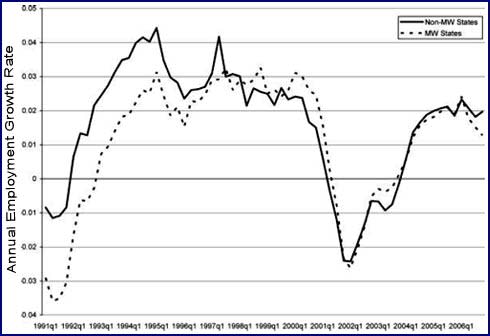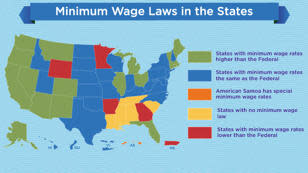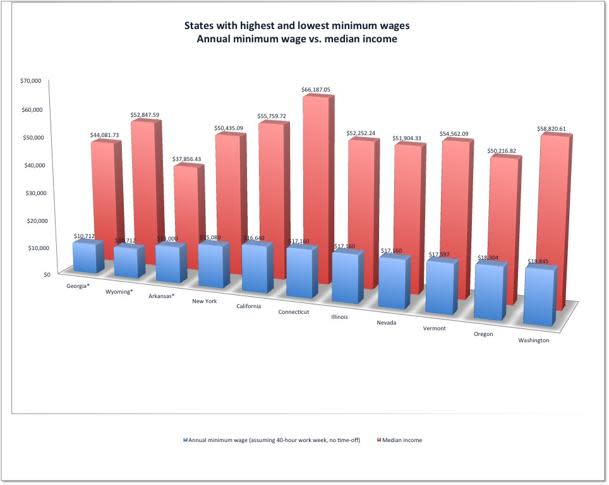 Trending Now
Trending NowY! Big Story: What the minimum wage gets you
Everything you need to know to get up to speed on the story of the day
What does $7.25 an hour get you?
These days, barely two gallons of gas. You'd probably have to work 30 minutes to enjoy a tall Frappuccino (maybe more if prices keep going up), although that's an indulgence when a box of diapers would cost about two hours of labor.
As the economy slowly rebuilds itself, talk about raising the minimum wage is, well, on the rise, and it has taken on more urgency in cities, states, and at the national level:
Eight states raised minimum wages on January 1.
Advocates in New York ($7.25/hr) are lobbying for $8.50, a pay raise that Governor Andrew Cuomo calls harder to pass than gay marriage.
Legislators in New Jersey ($7.25/hr) want to add $2,500 to a full-time minimum-wage annual salary that is indexed to inflation. Governor Chris Christie has said, "I'm showing a willingness to listen but also honestly saying I'm not inclined to do so."
Connecticut ($8.25/hr) lost momentum on its campaign to raise wages, although the issue is still percolating among legislators.
Missouri may vote on a November referendum.
Senator Tom Harkin (D-IA) introduced the Rebuild America Act in March, part of which addresses raising the federal minimum wage.
The debate over who benefits: It's clear who immediately profits from a wage bump—the current job-holder. But, the real back-and-forth revolves around who loses out because of a wage hike: Are increases a "job killer" (a $1.25/hour boost for one could mean no job for another), or will businesses benefit from better-paid consumers? Do the poor lose out, partly because they don't even work in the first place?
Then there's the impassioned debate over the "moral obligation:" Faith leaders talk about championing the "poor and needy," while the other side emphasizes the "moral imperative" of protecting job creation. In a speech commemorating a federal hourly wage raise 15 years ago, Robert Reich, Secretary of Labor under Bill Clinton, hinged the minimum wage concept to a "moral basis of our labor."

Declining purchasing power: While media coverage has defined the debate along party lines, politicians like Mitt Romney and President Barack Obama have agreed on one thing: Inflation has reduced the purchasing power of the minimum wage. "Over 30 years, we've had either stagnating, at best, or declining wages for our low-wage workers," says University of California at Berkeley labor economist Sylvia Allegretto to Yahoo!. "This idea that we can have a thriving economy, when we have a good swath of our workers losing ground in pay decade after decade, while those at the top are making more and more money, that does not make a successful economy."
Minimum wage by the numbers:
The last time there was a federal minimum wage boost was in 2009.
1.8 million workers earn $7.25/hour.
2.5 million workers earn less, due to exemptions that allow lower wages for certain types of workers (including students).
The same proportion of women work in occupations that depend upon tips, which has a federal minimum of $2.13/hour.
If wages were indexed to inflation since 1968 wages, which is the high point of American purchasing power, the minimum wage would be $10.58.
If wages rose at the same rate as executive salaries, the lowest-paid worker would make a whopping $23/hour.
The case study of the teen summer market:
Among those campaigning for minimum wage increases are kids barely old enough to land a job. A 12-year-old Girl Scout helped to galvanize the New York discussion on wages: Hannah Buckler started a petition to support a minimum wage increase. More than 3,000 miles away, students at a San Jose college pushed the city council to approve a November ballot initiative to raise its minimum wages and tie future increases to the cost of living.
Some economists, though, have focused on the younger generation as a prime example of the minimum wage's negative effects: Teens lose out on summer and part-time jobs because businesses can't afford to hire them. A recent effort has been underway to loosen child-labor laws. Some studies, however, dispute a causal connection.
Instead, academics like Allegretto say that the laws of supply and demand don't apply to minimum wage, pointing to the idea of monopsony. For instance, the way Apple and Wal-Mart have created their own supply chain and labor forces, illustrates monopsony in action.
To oversimplify: Basic economy theory believes that when the cost rises (in this case, labor costs), demand falls. But the buyer in this case is the employer paying below-competitive wages. "The wages are actually set below supply and demand," Allegretto says. "In theory, you can increase the wage and employment" and also reduce costly churn and recruitment at the same time. And while it's tempting to see this as a labor versus business dispute, coalitions like the Business for a Fair Minimum Wage, which includes companies like Costco, support minimum wage increases.
Sub-minimum wages: There's another class of wage-earners who make even less than the minimum: those who get tips on the job.
Like many tipped workers, [Zhanneta] Dunder has trouble making ends meet because of an obscure federal provision called the tip credit, which has established a sub-minimum wage for tipped workers at $2.15 per hour, or $4,333 a year for a full-time worker. Forty-five states have established slightly higher sub-minimum wages...Organizations like the New York nonprofit Restaurant Opportunities Centers don't think that's enough, and recommend at least raising tipped wages to 70 percent of the minimum wage...Tipped workers, the group says, are more likely to fall into poverty than those who receive minimum wage. Servers rely on food stamps at nearly double the rate of the general population. (May 23, Women eNews)
As with federal minimum wages, regions can choose to pay more. The San Francisco living wage rose to $10.24 on January 1; employers are also required to pay towards health care coverage, which diners have seen as a bill surcharge.
What is minimum wage throughout United States
? Although the federal minimum is $7.25, three states (Wyoming/$5.15, Georgia/$5.15, and Arkansas/$6.25) have lower state wages that apply to certain businesses and exemptions.
Below, a chart that contrasts the annual minimum-wage salary with a state's median income, for a sampling of states.






